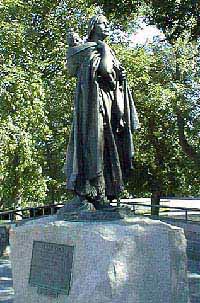
| Born: c. 1788 in Lemhi River Valley(near present-day Salmon, Idaho) |
| Died: Dec 20, 1812 (at age 24) in Fort Lisa, present-day North Dakota (probable) |
| Nationality: American Native (Shoshone) |
| Famous For: Joining the Lewis & Clark expedition |
Sacagawea was an important figure in American history who went on the famous Lewis and Clark Expedition. Sacagawea was a Lehmi Shoshone Indian woman who spoke Shoshone, Hidatsa and the English language. Thus, she had an essential part in the success of this expedition, being a guide as well as an interpreter. She is deemed a symbol of women’s merit and independence by the National American Woman Suffrage Association (NAWSA). To honor her memory and to acknowledge her significant contribution to the history of the United States, the US Mint issued the Sacagawea dollar coin in 2000 It depicted her and Jean Baptiste Charbonneau, her son. She was also inducted into the National Cowgirl Hall of Fame in 1977 and she was awarded in 2001 the title of Honorary Sergent by President Bill Clinton.
Historical Information
Although accurate info on her life is limited, it is believed that Sacagawea was born around 1788 in the Lehmi river Valley in Idaho. When she was around the age of twelve, she was kidnapped from her tribe of Lehmi Shoshone by a group of Hidatsa people, an enemy tribe of the Shoshone. At the age of thirteen, she became one of the two wives of Toussaint Charbonneau, a French-Canadian fur trader and explorer. He reportedly either purchased her from the Hidatsa people or won her while gambling. In 1804, she became pregnant with their first child, Jean Baptiste, who was nicknamed Little Pomp. In the same year, Meriwether Lewis and William Clark built Fort Mandan on the Missouri River and started recruiting members for their expedition. They were looking for interpreters and guides that could help their groundbreaking expedition up the Missouri River and to the Pacific Ocean.
Expedition
Her role in this expedition is known in detail thanks to the eight volumes of journals written by captains Lewis and Clark. Due to the fact that she spoke Shoshone, she was hired as a guide and interpreter together with her husband, Toussaint, who also spoke French and the Hidatsa language.
She helped the expedition members find a passageway through the unexplored Northwest land of her own tribe. This was even though she knew that she was assisting Americans in their invasion of her peoples’ sacred territory. Within the Shoshone Bands, little girls were mistreated; they were beaten and forced to do all the hard work. In addition, Shoshone women were forced by their husbands to become prostitutes. Between 1804 and 1806, while serving as an important member of the expedition, she earned the respect and admiration of the rest of the members. This brave woman was appreciated not only for her courage, but for her intelligence, strength and resilience.
Death
According to several sources Sacagawea passed away on December 20th, 1812 of putrid fever at the age of 24, in Fort Lisa, North Dakota. She was survived by her husband and by her son, Jean Baptiste Charbonneau, who became an explorer, guide and interpreter.